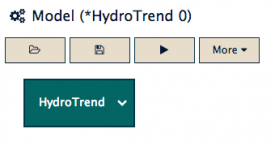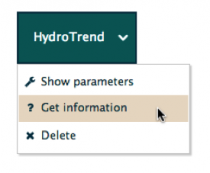WMT tutorial
The CSDMS Web Modeling Tool (WMT) is the web-based successor to the desktop CSDMS Modeling Tool (CMT). WMT allows users to build and run coupled surface dynamics models on a high-performance computing cluster (HPCC) from a web browser on a desktop, laptop or tablet computer.
This article gives a short tutorial on how to use WMT. For an overview of the buttonology of WMT, please see WMT Help.
Open WMT
In a web browser, go to
to open WMT.
Sign in
Sign in to WMT with an email and a password.

You have to be signed in to save and run models. If this is the first time you're signing in to WMT, you'll be prompted to repeat your password.
Select a driver for the model
To create a new model in WMT, you must start by selecting a component to act as the driver of the model.
In the Model panel, click the driver button and choose HydroTrend from the list of components displayed.

This adds HydroTrend as the driver of the model, as the Model panel now shows.

WMT has also given a generic Model title to the new model, based on the name of the driver component. We'll chose a more specific title when we save the model.
Get information on a model component
The HydroTrend model component you just added now acts as a button. Clicking it displays a new menu with a set of actions that can be performed on the model component.

Let's choose to Get information on HydroTrend. Selecting this menu item displays a pop-up window giving the component name, version, DOI, a brief summary of its functionality, a link to the component's help page, and the author of the component.

For detailed infomation, you can follow the link to the component help page on the CSDMS web site.
Edit a component parameter
When HydroTrend was selected, its parameters were displayed in the Parameter panel.

Each parameter used by HydroTrend is listed with a reasonable default value chosen by the developer. Try hovering over the first parameter, Simulation run time.

In addition to the default value, note that each parameter displays its range of possible values as a tooltip.
Each parameter is also editable.
Change the Simulation run time parameter from 100 to 365 days by entering the value 365 in the parameter's value box and selecting the <Enter> key.
Note that you can use scientific notation: 365 could be entered as 3.65E2.
[1]
If an out-of-range value is entered for a parameter, the value box turns red.

A model can still be saved and executed with out-of-range parameters present, but the results may be invalid. For this tutorial, use an in-range value of 365 days.
Add labels to the model
Model labels are used to group and categorize models in WMT. Attaching labels to a model can make it easier to find the model at a later time.
Open the Manage labels menu under the ![]() More... button in the Model panel.
More... button in the Model panel.
(Show a picture here!)
Here you'll see a list of all public labels, shared among the community, as well as the private labels that belong only to you. You'll see that a public label for HydroTrend (as the driver) has already been selected for this model.
We can also add our own private labels. Let's add another private label, such as example or tutorial, to the model.
Save the model
Next, save the model by selecting the ![]() Save button in the Model panel.
Save button in the Model panel.
The model is saved at CSDMS. Anywhere you can access WMT, you can access your saved models. For example, you could design a model at your office, save it, and open it again on your home computer to edit it.
Give the model a name.
Note that labels are selected: HydroTrend and your email address. Make a new label that describes this model. (E.g., "tutorial")
Run the model
Standalone mode.
Check the status page.
Download the model output
Foo.
Notes
- ↑ Note the use of uppercase "E"; lowercase "e" won't work.
